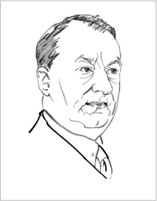

It is very probable that technologies and solutions developed outside your own sector will have the greatest influence on the path taken by your organization or domain of activity. The same applies inside your organization, where excellent solutions await if you systematically link knowledge from different areas of activity. Ettore Bugatti (1881–1947) showed how effectively separate disciplines can be teamed up to produce wonderful results.
Ettore Bugatti made automobiles that combined unusual construction with highly aesthetic designs. These rolling works of art met with amazement, eliciting almost boundless enthusiasm. Bugatti succeeded in marrying different disciplines in previously unimagined ways and created something entirely new out of advanced technology, top-quality production, and truly artistic car body designs. This was how the Bugatti brand attained unrivaled, true cult status between the Golden Twenties and the outbreak of World War II. Looking back over a long list of exceptional racing cars, like Bugatti’s Type 29 and Type 32 or the luxurious Type 41 Royale, many Bugatti aficionados thought the brand’s days were over when Ettore Bugatti died in 1947. Indeed, the Bugatti company was forced to stop production in 1956.
A first attempt to revive the brand was made by Romano Artioli in 1987, and just four years later the 12-cylinder EB 110 was unveiled in Paris to coincide with the 110th anniversary of Ettore Bugatti’s birth. However, the company proved unable to hold its own in the market and was forced to file for bankruptcy in 1995. When Volkswagen acquired Bugatti in 1998, the aesthetic tradition started by Ettore Bugatti was continued in the shape of a new supercar. The dream was to build a production vehicle that once again uniquely combined aesthetic appeal with high technology. The resulting automobile was intended to perform like a Formula 1 race car while at the same time being suitable for everyday use, thus marrying extreme innovation with noble tradition and great design. The outcome was unquestionably an utter masterpiece: the Veyron 16.4, with a top speed of 257 mph, a 1,200-horsepower engine, and acceleration from 0 to 60 mph in under 3 seconds—all wonderfully packaged in an aesthetically appealing design. Note how this result could be achieved only by combining specialist knowledge from different disciplines.
Technologies leap from sector to sector with breathtaking speed and end up no longer being specific to any individual field. At the same time, sectoral knowledge itself is increasingly being derived from other areas of activity. This is why you need to seek solutions in other sectors that could also prove useful in your primary business segment.
For example, fiber optic cables have revolutionized the entire telecommunications sector, yet they were invented not by a company active in that domain, but rather by the glass company Corning Inc.
The creation of NASA in 1958 also constituted an attempt to reap benefits from bringing together people from different programs and domains. NASA’s inception was galvanized by the Soviet Union’s launch of Sputnik, beating the United States in the race to put a satellite into orbit around the Earth. As a result, NASA organized a research lab without walls.
NASA is no exception. Practically all organizations have incredible untapped potential because they do not adopt a systematically interdisciplinary approach in their quest to find better, more effective solutions. If you want to make a major contribution toward your organization’s development, take steps to ensure that complex problems are solved by people from all parts of it in a truly interdisciplinary approach and that major opportunities are properly exploited the same way. Finding solutions without walls can make a huge difference, whether you’re striving for the swift, successful implementation of a change process, overseeing the adoption of a new strategic tack, coming to terms with a merger, targeting long-term savings, penetrating new markets, boosting the quality of products or services, or seeking to lastingly improve internal processes and procedures. To achieve any of these objectives, gather together your brightest people.
![]() Establish a procedure for regularly scouting other sectors for new trends, technologies, and know-how that could prove useful for your organization.
Establish a procedure for regularly scouting other sectors for new trends, technologies, and know-how that could prove useful for your organization.
![]() When do you next plan to bring together the best people from throughout your organization at an off-site session to approve a bundle of measures for solving the toughest problems you face and making the most of your biggest opportunities?
When do you next plan to bring together the best people from throughout your organization at an off-site session to approve a bundle of measures for solving the toughest problems you face and making the most of your biggest opportunities?